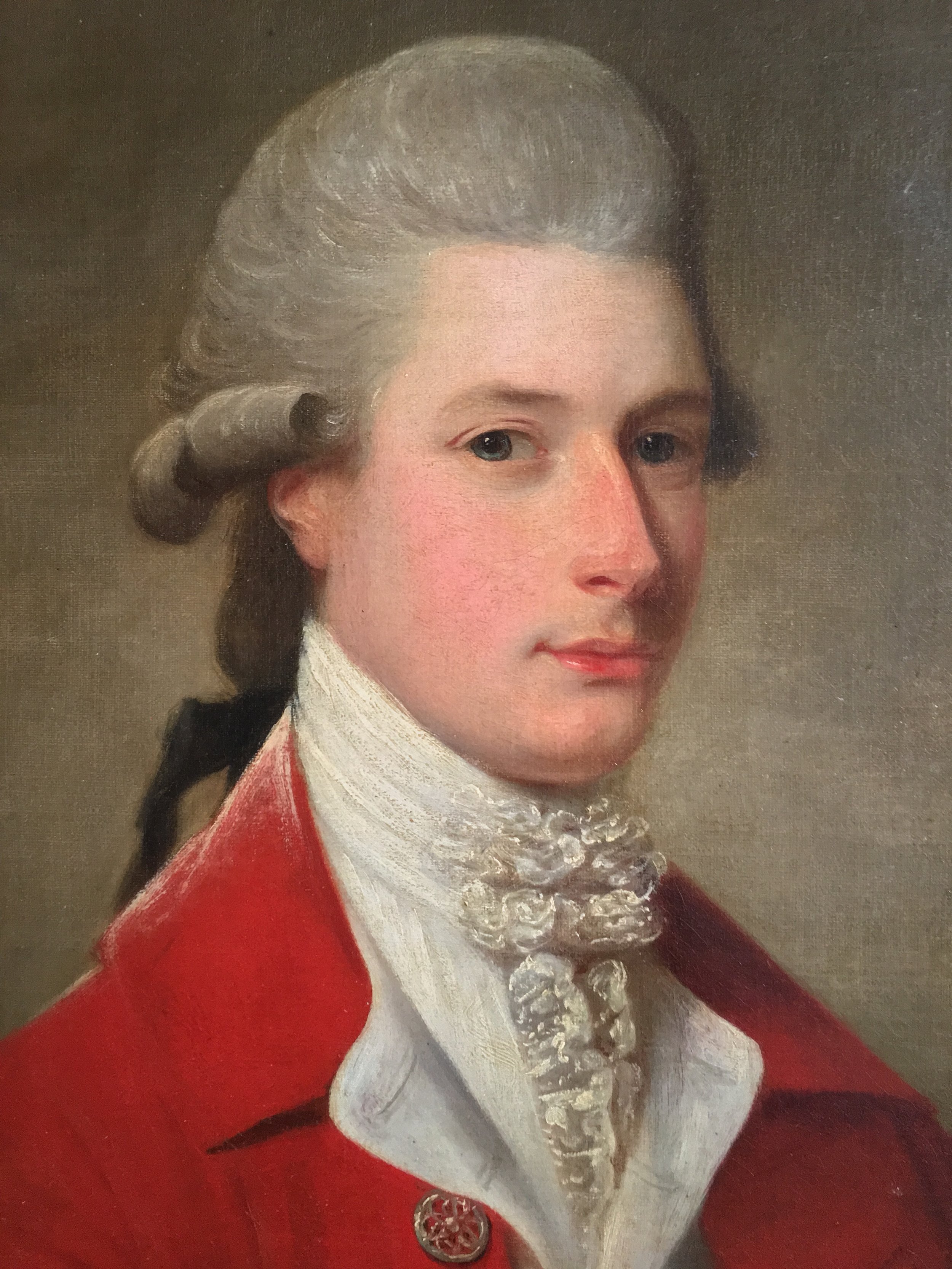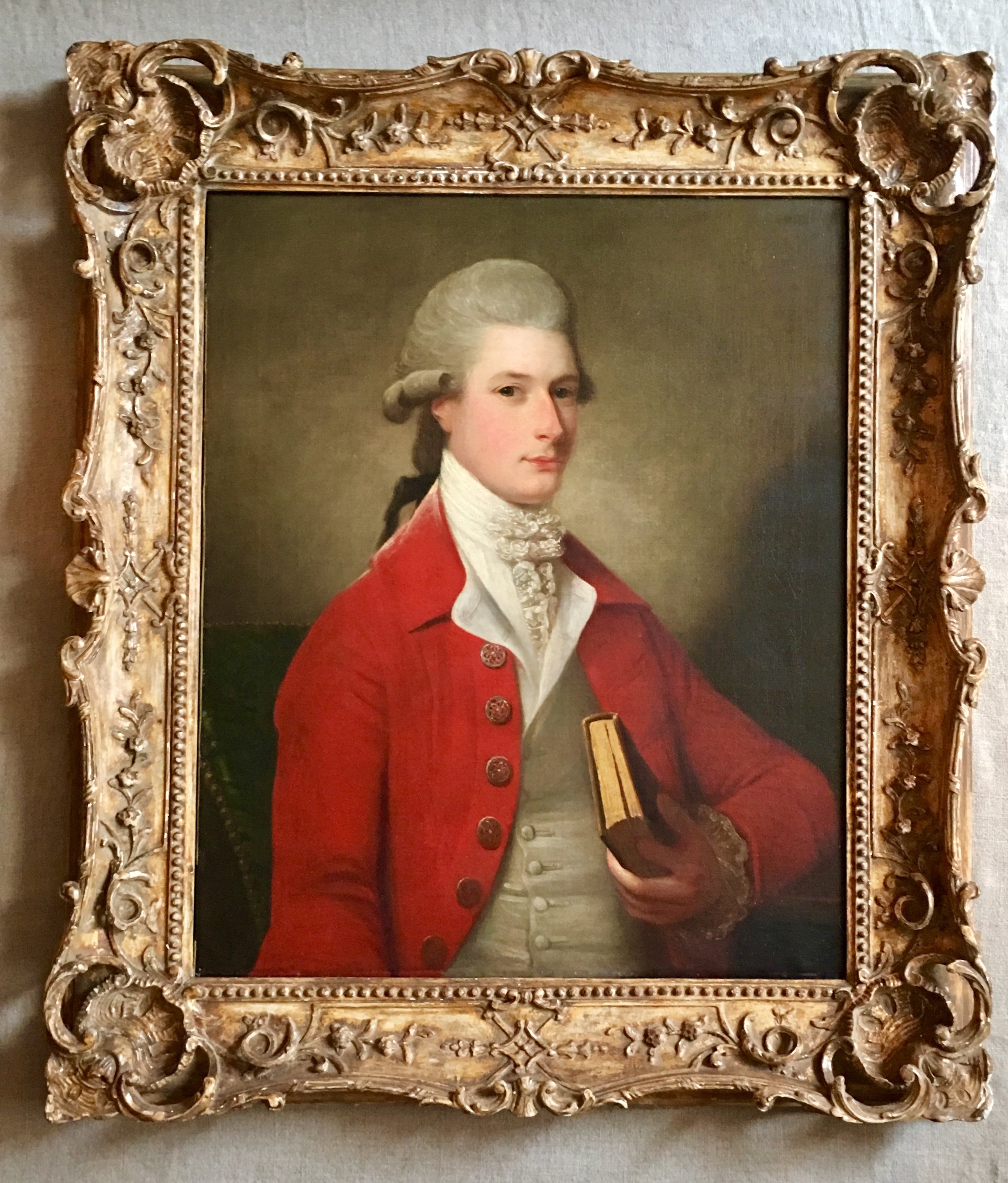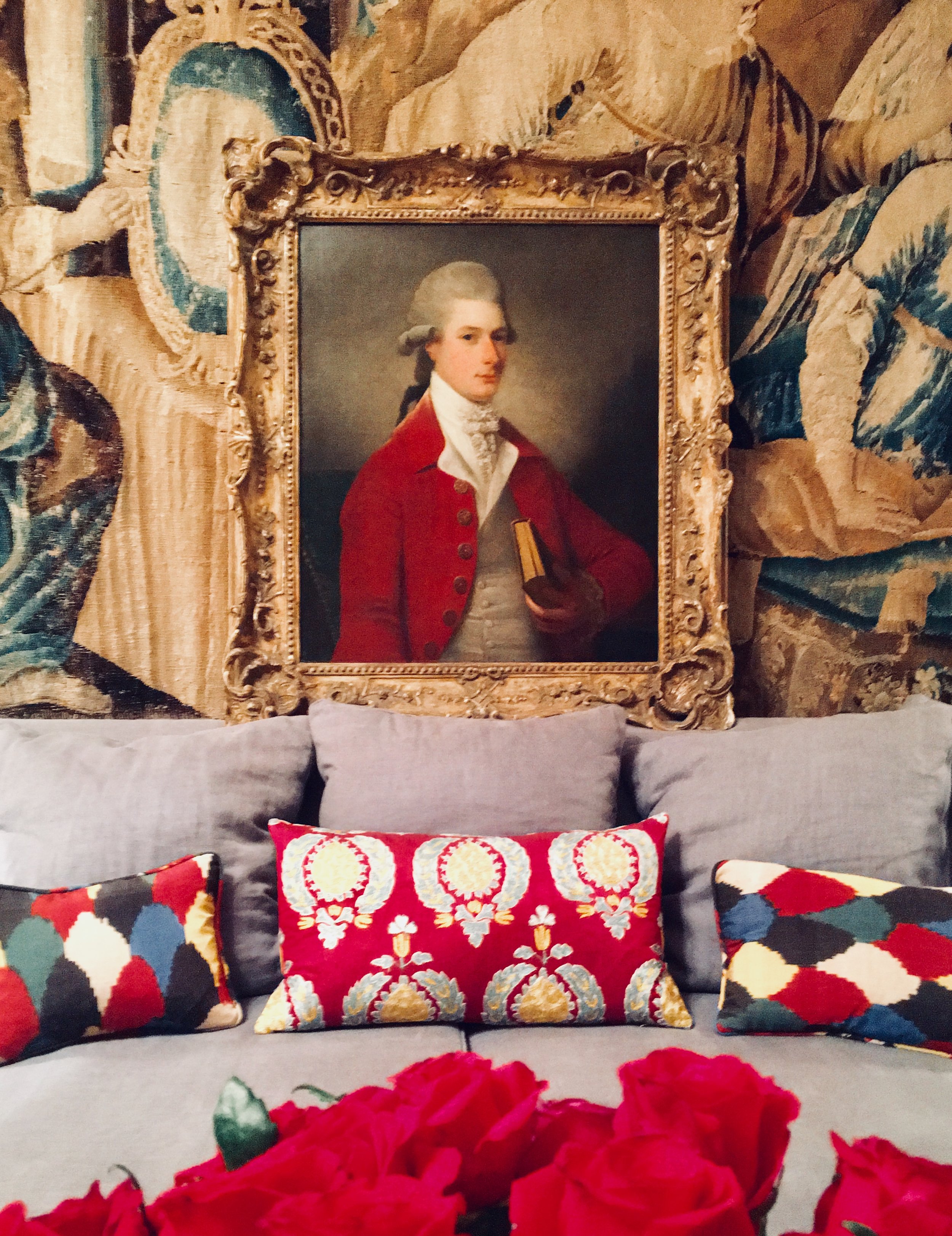




SOLD
PORTRAIT OF SIR ARCHIBALD SEATON BY DAVID MARTIN.
A fine and sensitively rendered 18th century British portrait of The Honourable Sir Archibald Seton Baron Touch and Tullibody Hereditary Armour Bearer to the King President at the Court of his Majesty Shah Alam II at Delhia Wearing a red coat, signed David Martin (Signed Martin Pinxit 1780) Housed in a particularly fine hand carved and gilded frame from The House of Heydenryk New York.
Archibald Seton, Esq. (b. 1758 d. March 30, 1818), son of Hugh Seton (Smith) and Elizabeth Seton of Touch, Heritable Armour Bearer & Squire of the King's body; Governor of Prince of Wales' Island and Member of the Supreme Council Bengal, Writer in the East India Company (1779); President at the Court of his Majesty Shah Alam II, at Delhi (1806); Governor of Penang from (1811-1812).
He was passed the Touch and Allanton estate from his ambitious father while a relatively young man, during the lifetime of his father who left the estate in considerable debt. Archibald, determined to clear the estates of debt, joined the East India Company and sailed to India in 1779.
The lure of riches and the hope of advancement drew some of the most capable minds of a generation to the East. Those already in India when the Ship Stormont arrived included names that would soon play key roles in the Company's civil and military service, including Archibald Seton, writer of 1779. He was part of the generation that bridged the gap between the old mercantile-minded Company of the pre-Warren Hastings period and the new, imperialist one of the post-Wellesley era, and developed the ideology, perfected the institutions and trained the minds that administered and expanded the Company's Indian empire.
He was a member of the Supreme Council at Fort William, Bengal, Lieutenant-Governor of the Prince of Wales' Island (Penang), President at the court of his Majesty Shah Allum at Delhi, among the many other roles he played during his long civil service with the British East India Company. In 1780, in early life, Mr. Seton went to Bengal in the civil service of the East India Company, where he remained during the protracted period of thirty-eight years. In this long interval he was successively employed in the execution of the duties of many of the most important office's in the administration of the affairs of our great and extensive empire, the East: and it is not more than simple justice to Mr. Seton to declare, that his conduct in the discharge of the functions of every situation which he filled, was equally honourable to himself, advantageous to the State, and calculated to promote the permanent comfort and happiness of the subjects of the Government whose welfare was entrusted to his charge.
After passing through the routine of early service in India with much credit to himself, Mr. Seton was successively entrusted with the charge of the collection of the Revenue, and the administration of Civil and Criminal Justice, in the Districts of Bhangolpore and Behar. He was then promoted to a seat in the Provincial Court of Justice in the Province of Behar ; and on the occasion of the cession of a portion of the dominions of the Nabob Vizier to the East India Company, in 1801, be was removed to the same station in the ceded provinces, and was one of the Gentlemen selected by Marquis Wellesley to assist Sir Henry Wellesley in the discharge of the trust of the office of Lieutenant governor of those Provinces.
During the first few months of Britain's governance at Bareilly in 1804, a magistrate, Fitzroy, in a dispute concerning a garden, struck a Sayud and a cry went up, "A Seyud has been insulted and struck; our houses are about to be demolished..." Archibold Seton, the Governor-General's agent at Bareilly fearing an uprising would overcome the small British occupying force made his way to the Mosque of the popular and respected Moftee Mahomed Ewuz. Seton was first barred entry as he removed his shoes to enter the mosque but was subsequently let go as he said to the guards, "Do you not see, my friends, that I am prepared to approach a sacred place, and meet a holy man."
In 1806, Mr. Seton was appointed to the office of President at the Court of his Majesty Shah Alam II, at Delhi, and performed the grateful duty of securing the happiness of the last few months of the life of that interesting Prince, and also of providing for the comfort of his son and successor, the Emperor of Hindustan, on the accession of the latter to the Musnud. The arrangements made by Mr. Seton tor the management of the territory to the Westward of theJamuna, assigned for the maintenance of the Royal Family at Delhi, during the years in which he retained the office of President at his Majesty's Court from 1806 to 1811, were equally honourable to his own character, and well calculated to promote the welfare of all classes of the inhabitants of that territory ; and their advantages have been permanent.
In 1811, Seton accompanied Gilbert Elliot-Murray-Kynynmond, 1st Earl of Minto on the expedition against the Island of Java; and after the successful conquest of that island, he was appointed to the office of Governor of Prince of Wales' Island (Penang). He was Lieutenant-Governor there from 9 May 1811 to 27 July 1812 but was absent on duty with The Java Expedition from 13 May 1811 until the end. From Lieutenant-Governor of the Prince of Wales' Island, he was promoted in 1812, by the Court of Directors of the East India Company as reward of his long services, to a seat in the Supreme Council at Fort William in Bengal, which he filled with much credit for five years, and was on his return to his native country in 1818, at the period of his death. Archibald Seton died on board the East India Company's ship William Pitt (Capt. Graham), on the passage from St. Helena to England on March 30, 1818, aged 60. During the long period of Mr. Seton's services, he had the happiness to possess in succession, and in the fullest extent, the well-merited confidence of every Government under which he served — that of Marquis Cornwallis, Lord Teignmouth, Marquis Wellesley, Sir George Barlow, and the Earl of Minto : and the friend by whom this faint tribute is paid to his memory, and by whom his virtues will ever, be revered, can assert, from an intimate knowledge for a period of nearly forty years, that his desire to promote the happiness of others was uniformly enthusiastic, and that the virtues of his heart were pure, and unmixed with any tincture of alloy. Archibald rose to high office, accumulated a considerable sum of money but sadly died on his way home before reaching Touch on whose behalf he has worked all his life. Archibald's sister, Barbara, married Sir Henry Stuart of Allanton and inherited the estate. Sir Henry was a well known aboriculturist and planted many of the fine trees on Touch. He took the name of Seton-Steuart and their family remained the lairds of Touch until it passed to the Buchanans in 1928.
David Martin (1 April 1737 – 30 December 1797) This celebrated British painter and engraver was born in Fife, Scotland, he studied in London and Italy, before gaining a reputation as a portrait painter. He accompanied the portrait painter Allan Ramsey on his tour of Italy in 1756–7, having already been taught by him, and after returning became a student at the St Martin’s Lane Academy in London. There he gained premiums for life drawing in each year from 1759 to 1761. He also joined Ramsay's studio as its principal draughtsman, in the 1760s helping to produce many of the coronation portraits of George III and Queen Charlotte.
He had his own studio by 1770, by which time he had also produced his first self-portrait (now in the National Gallery of Scotland) Martin painted over 300 portraits in his lifetime. One of the earliest independent ones is the 1767 one of Benjamin Franklin (now in the White House, Washington D.C ). Martin exhibited at the Incorporated Society of Atrists from 1765 to 1777 (being elected its treasurer, vice-president, and president between 1772 and 1777), at the Free Society of Artists in 1767 and at the Royal Academy in 1779 and 1790.
In 1780, Martin returned to Edinburgh (but not selling his home in High Street, Dartford, until 1782), a move signalled by his admittance to the Royal Company of and a rare full-length portrait he painted of its president, Sir james of Stichill (1791–4). In 1785 he was appointed principal painter to the Prince of Wales in Scotland. Martin died in 1797 at his home, 4 St James Square, Edinburgh, and was buried in Leith South churchyard on 3 January 1798, with his home contents and studio contents sold at auction in 1799 (in an auction taking 21 days).
Canvas: 25" x 30", 64 cm x 76cm. Framed: 35" x 40", 89 cm x 102 cm.
Provenance: Old Private Collection, Philadelphia, USA.
Higher resolution images on request. Worldwide shipping available.

